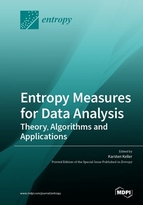Entropy Measures for Data Analysis: Theory, Algorithms and Applications
A special issue of Entropy (ISSN 1099-4300).
Deadline for manuscript submissions: closed (30 April 2019) | Viewed by 58412
Special Issue Editor
Interests: data analysis; time series analysis; computational statistics; information theory; ergodic theory; automatic learning
Special Issues, Collections and Topics in MDPI journals
Special Issue Information
Dear Colleagues,
Entropies and entropy-like quantities are playing an increasing role in modern non-linear data analysis. Fields of their application reach from diagnostics in physiology, for instance, electroencephalography (EEG), magnetoencephalography (MEG) and electrocardiography (ECG), to econophysics and engineering. During the last few years, classical concepts as the Approximate entropy and the Sample entropy have been supplemented by new entropy measures, like the Permutation entropy and various variants of it. Recent developments are focused on multidimensional generalizations of the concepts with a special emphasize on the quantification of coupling between time series and system components behind them. Some of the main future challenges in the field are a better understanding of the nature of the various entropy measures and their relationships, with the aim of their adequate application including good parameter choices. The utilization of entropy measures as features in automatic learning and their application to large and complex data for tasks as classification, discrimination and finding structural changes requires fast and well-founded algorithms.
Prof. Dr. Karsten KellerGuest Editor
Manuscript Submission Information
Manuscripts should be submitted online at www.mdpi.com by registering and logging in to this website. Once you are registered, click here to go to the submission form. Manuscripts can be submitted until the deadline. All submissions that pass pre-check are peer-reviewed. Accepted papers will be published continuously in the journal (as soon as accepted) and will be listed together on the special issue website. Research articles, review articles as well as short communications are invited. For planned papers, a title and short abstract (about 100 words) can be sent to the Editorial Office for announcement on this website.
Submitted manuscripts should not have been published previously, nor be under consideration for publication elsewhere (except conference proceedings papers). All manuscripts are thoroughly refereed through a single-blind peer-review process. A guide for authors and other relevant information for submission of manuscripts is available on the Instructions for Authors page. Entropy is an international peer-reviewed open access monthly journal published by MDPI.
Please visit the Instructions for Authors page before submitting a manuscript. The Article Processing Charge (APC) for publication in this open access journal is 2600 CHF (Swiss Francs). Submitted papers should be well formatted and use good English. Authors may use MDPI's English editing service prior to publication or during author revisions.
Keywords
- data analysis
- complexity measures
- entropy
- approximate entropy
- sample entropy
- permutation entropy
- classification
- discrimination
- automatic learning







